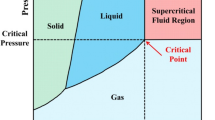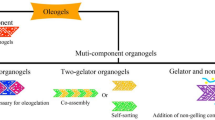Abstract
The structure and stability of ternary systems prepared with polysorbate 60 and various combinations of cetyl (C16) and stearyl (C18) alcohols were examined as they aged over 3 months at \(25^\circ C\). Rheological results showed that the consistency of these systems increased initially during roughly the first week of aging, which was succeeded by little changes in consistency (systems containing from 30% to 70% C18, with the 50% C18 system showing the highest consistencies) or significant breakdown of structure (remaining systems). The formation and/or disintegration of all ternary systems were also detected by microscopy and differential scanning calorimetry experiments. This study emphasizes the fact that the structure and consistency of ternary systems are dominantly controlled by the swelling capacity of the lamellar gel phase. Molecular dynamics simulations were performed to provide details on the molecular mechanism of stability. Computational results support the hypothesis experimentally proposed for the stability of the mixed system being due to an increased flexibility of the alcohol with a longer hydrocarbon chain. Computational results are in excellent agreement with experimental conclusions. Additionally, they show that in the mixed system, alcohols with shorter hydrocarbon chain become more rigid. These molecular details could not be available in experimental measurements.













Similar content being viewed by others
References
Engels T, von Rybinski W (1998) Liquid crystalline surfactant phases in chemical applications. J Mater Chem 8(6):1313–1320
Ahmadi D, Mahmoudi N, Heenan RK, Barlow DJ, Lawrence MJ (2020) The influence of co-surfactants on lamellar liquid crystal structures formed in creams. Pharmaceutics 12(9):864
Datta A, Tanmay VS, Tan GX, Reynolds GW, Jamadagni SN, Larson RG (2020) Characterizing the rheology, slip, and velocity profiles of lamellar gel networks. J Rheol 64(4):851-862
Iwata T (2017) Stabilization of emulsion by \(\alpha -\)gel. Pharm Tech Japan 33(01):75–82
Vu HD, Tran HH, Cong CP, Nguyen HM, Nguyen TT (2019) Investigating molecular mechanism for the stability of ternary systems containing cetrimide, fatty alcohol and water by using computer simulation. J Mol Graph Model 95:107500
Korhonen M, Niskanen H, Kiesvaara J, Yliruusi J (2000) Determination of optimal combination of surfactants in creams using rheology measurements. Int J Pharm 197:143–151
Barry BW (1970) Rheology of emulsions stabilized by sodium dodecyl sulfate/long-chain alcohols. J Colloid Interface Sci 32(3):551–560
Eccleston GM (1976) The structure and rheology of pharmaceutical and cosmetic creams. Cetrimide creams; The influence of alcohol chain length and homolog composition. J Colloid Interface Sci 57(1):66-74
Eccleston GM (1982) The influence of fatty alcohols on the structure and stability of creams prepared with polyethylene glycol 1000 monostearate/fatty alcohols. Int J Cosmet Sci (4):133–42
Eccleston GM (1985) Phase transition in ternary systems and oil-in-water emulsions containg cetrimide and fatty alcohols. Int J Pharm 27:311–323
Fukushima S, Yamaguchi M, Harusawa F (1977) Effect of cetostearyl alcohol on stabilization of oil-in-water emulsion: Ii. relation between crystal form of the alcohol and stability of the emulsion. J Colloid Interface Sci 59:159–165
Eccleston GM (1977) Structure and rheology of cetomacrogol creams: the influence of alcohol chain length and homologue composition. J Pharm Pharmacol 29, 157–162
Fukushima S, Takahashi M, Yamaguchi M (1976) Effect of cetostearyl alcohol on stabilization of oil-in-water emulsion: I. difference in the effect by mixing cetyl alcohol with stearyl alcohol. J Colloid Interface Sci 57:201–206
Sepulveda E, Kildsig D, Ghaly E (2003) Relationship between internal phase volume and emulsion stability: The cetyl alcohol/stearyl alcohol system. Pharm Dev Technol 8:263–275
Talman F, Rowan E (1970) Some observations on the use of fatty alcohols and fatty acids to increase the consistency of oil-in-water emulsions. J Pharm Pharmacol 22:338–344
Eccleston GM (1977) Functions of mixed emulsifiers and emulsifying waxes in dermatological lotions and creams. Colloids Surf A Physicochem Eng Asp 123:169–182
Ballmann C, Mueller B (2008) Stabilizing effect of cetostearyl alcohol and glycerylmonstearate as co-emulsifiers on hydrocarbon-free o/w glyceride creams. Pharm Dev Technol 13:433–445
Estanqueiro M, Conceição J, Amaral M, Lobo J (2014) Characterization, sensorial evaluation and moisturizing efficacy of nanolipidgel formulations. Int J Cosmet Sci 36:159–166
Masmoudi H, Piccerelle P, Le Dréau Y, Kister J (2006) A rheological method to evaluate the physical stability of highly viscous pharmaceutical oil-in-water emulsions. Pharm Res 23:1937–1947
Kónya M, Sorrenti M, Ferrari F, Rossi S, Csoka I, Caramella C, Bettinetti G, István E (2003) Study of the microstructure of o/w cream with thermal and rheological methods. J Therm Anal Calorim 73:623–632
Olejnik A, Kapuscinska A, Schroeder G, Nowak I (2017) Physico-chemical characterization of formulations containing endomorphin-2 derivatives. Amino Acids 49:1719–1731
Olejnik A, Schroeder G, Nowak I (2015) The tetrapeptide n-acetyl-pro-pro-tyr-leu in skin care formulations-physicochemical and release studies. Int J Pharm 492:161–168
Ribeiro H, Morais J, Eccleston GM (2004) Structure and rheology of semisolid o/w creams containing cetyl alcohol/non-ionic surfactant mixed emulsifier and different polymers. Int J Cosmet Sci 26:47–59
Savic S, Vuleta G, Daniels R, Müller-Goymann C (2005) Colloidal microstructure of binary systems and model creams stabilized with an alkylpolyglucoside non-ionic emulsifier. Colloid Polym Sci 283:439–451
Savic S, Weber C, Tamburic S, Savic M, Müller-Goymann C (2009) Topical vehicles based on natural surfactant/fatty alcohols mixed emulsifier: The influence of two polyols on the colloidal structure and in vitro/in vivo skin performance. J Pharm Sci 98:2073–2090
Ouyang D, Smith S (2015) Computational pharmaceutics: Application of molecular modeling in drug delivery. John Wiley & Sons ch. 4, 6-11, pp. 53–80, 101–233
Zhao Q, Miriyala N, Su Y, Chen W, Gao X, Shao L, Wang Y, Yan R, Li H, Yao XJ, Cao DS, Ouyang D (2018) Computer-aided formulation design for a highly soluble lutein-cyclodextrin multiple-component delivery system. Mol Pharm 15:1664–1673
Snyder R, Maroncelli M, Strauss H, Elliger C, Cameron D, Casal H, Mantsch H (1983) Distribution of gauche bonds in crystalline n-c21h44 in phase ii. J Am Chem Soc 105:133–134
Commission BP (2016) British Pharmacopoeia 2016, vol. II. London: TSO, 2016, pp. 617–618. Polysorbate 60 monograph
Frisch MJ, Trucks GW, Schlegel HB, Scuseria GE, Robb MA, Cheeseman JR, Scalmani G, Barone V, Petersson GA, Nakatsuji H, Li X, Caricato M, Marenich AV, Bloino J, Janesko BG, Gomperts R, Mennucci B, Hratchian HP, Ortiz JV, Izmaylov AF, Sonnenberg JL, Williams-Young D, Ding F, Lipparini F, Egidi F, Goings J, Peng B, Petrone A, Henderson T, Ranasinghe D, Zakrzewski VG, Gao J, Rega N, Zheng G, Liang W, Hada M, Ehara M, Toyota K, Fukuda R, Hasegawa J, Ishida M, Nakajima T, Honda Y, Kitao O, Nakai H, Vreven T, Throssell K, Montgomery Jr JA, Peralta JE, Ogliaro F, Bearpark MJ, Heyd JJ, Brothers EN, Kudin KN, Staroverov VN, Keith TA, Kobayashi R, Normand J, Raghavachari K, Rendell AP, Burant JC, Iyengar SS, Tomasi J, Cossi M, Millam JM, Klene M, Adamo C, Cammi R, Ochterski JW, Martin RL, Morokuma K, Farkas O, Foresman JB, Fox DJ (2017) Gaussian16 Revision A.03, 2017. Gaussian Inc. Wallingford CT
Rassolov V, Ratner M, Pople J, Redfern P, Curtiss L (2001) 6-31g*basis set for third-row atoms. J Comput Chem 22:976–984
Stephens P, Devlin F, Chabalowski C, Frisch M (1994) Ab initio calculation of vibrational absorption and circular dichroism spectra using density functional force fields. J Phys Chem 98:11623–11627
Woods R, Chappelle R (2000) Restrained electrostatic potential atomic partial charges for condensed-phase simulations of carbohydrates. J Mol Struct THEOCHEM 527:149–156
Ferrando N, Lachet V, Teuler JM, Boutin A (2009) Transferable force field for alcohols and polyalcohols. J Phys Chem B 113:5985–5995
Jämbeck J, Lyubartsev A (2012) Derivation and systematic validation of a refined all-atom force field for phosphatidylcholine lipids. J Phys Chem B 116:3164–3179
Eccleston GM, Behan-Martin M, Jones G, Towns-Andrews E (2000) Synchrotron x-ray investigations into the lamellar gel phase formed in pharmaceutical creams prepared with cetrimide and fatty alcohols. Int J Pharm 203:127–139
Darden T, York D, Pedersen L (1992) Particle mesh ewald: An \(n\log (n)\) method for ewald sums in large systems. J Chem Phys 98:10089–10092
Hess B, Bekker H, Berendsen H, Fraaije J (1997) Lincs: A linear constraint solver for molecular simulations. J Comput Chem 18:1463–1472
Abraham M, Murtola T, Schulz R, Páll S, Smith J, Hess B, Lindahl E (2015) Gromacs: High performance molecular simulations through multi-level parallelism from laptops to supercomputers. SoftwareX 1:19–25
Berendsen HJ, van der Spoel D, van Drunen R (1995) GROMACS: a message-passing parallel molecular dynamics implementation. Comp Phys Commun 91:43–56
Vermeer LS, de Groot BL, Reat V, Milon A, Czaplicki J (2007) Water dielectric effects in planar confinement. Eur Biophys J 36:919–931
Tanaka K, Seto T, Hayashida T (1958) Phase transformation of n-higher alcohols. (i). Bull Inst Chem Res, Kyoto Univ 35:123–139
Vringer T, Joosten JG, Junginger H (1986) A study of the gel structure in a nonionic o/w cream by differential scanning calorimetry. Colloid Polym Sci 264:691–700
Stewart F (1960) Phase relationships and spreading behaviour of cetyl alcohol mixtures. Aust J Appl Sci 11:157–168
Savic S, Vuleta G, Daniels R, Müller-Goymann C (2005) Colloidal microstructure of binary systems and model creams stabilized with an alkylpolyglucoside non-ionic emulsifier. Colloid and Polym Sci 283:439–451
Eccleston GM (1986) The microstructure of semisolid creams. Pharm Int 7:63–70
Jungfinger H, Heering W, Führer C, Geffers I (1981) Elektronenmikroskopische untersuchungen über den kolloidchemischen aufbau von salben und cremes. Colloid Polym Sci 259(5):561–567
Junginger H (1984) Colloidal structures of o/w creams. Pharm Weekbl 6(4):141–149
Pena LE, Lee BL (1993) Consistency development and destabilization of a model cream. J Soc Cosmet Chem 44:337–345
Dahl V, Friedrich A, Meyer J, Venzmer J, Belkoura L, Strey R, Mayer C, Michel R, Gradzielski M (2018) Structural analysis of a modern o/w-emulsion stabilized by a polyglycerol ester emulsifier and consistency enhancers. Colloids Interfaces 2(1):3
Alam MM, Ushiyama K, Aramaki K (2009) Phase behavior, formation, and rheology of cubic phase and related gel emulsion in tween80/water/oil systems. J Oleo Sci 58(7):361–367
Züge LCB, Haminiuk CWI, Maciel GM, Silveira JLM, de Paula Scheer A (2013) Catastrophic inversion and rheological behavior in soy lecithin and tween 80 based food emulsions. J Food Eng 116(1):72–77
Teixeira GL, Züge LCB, Silveira JLM, de Paula Scheer A, Ribani RH (2016) The impact of polyoxyethylene sorbitan surfactants in the microstructure and rheological behaviour of emulsions made with melted fat from cupuassu (theobroma grandiflorum). J Surfactants Deterg 19(4):725–738
Morales R, Martinez M, Pilosof A (2019) Caseinglycomacropeptide and polysorbate interactions allow the design of smart gelled emulsions. Food Hydrocoll 93:198–205
Luo N, Ye A, Wolber FM, Singh H (2020) In-mouth breakdown behaviour and sensory perception of emulsion gels containing active or inactive filler particles loaded with capsaicinoids. Food Hydrocoll 108:106076
Kónya M, Dékány I, Erõs I (2007) X-ray investigation of the role of the mixed emulsifier in the structure formation in o/w creams. Colloid Polym Sci 285(6):657–663
Comission BP (2016) British Pharmacopoeia 2016, vol. I. London: TSO, 2016, pp. 490–491. Cetostearyl alcohol monograph
Caritá AC, Resende de Azevedo J, Vinícius Buri M, Bolzinger MA, Chevalier Y, Riske KA, Ricci Leonardi G (2021) Stabilization of vitamin c in emulsions of liquid crystalline structures. Int J Pharm 592:120092
Funding
This research is supported by the Vietnam National Foundation for Science and Technology Development (NAFOSTED) under grant number 104.99-2016.39.
Author information
Authors and Affiliations
Corresponding authors
Ethics declarations
Conflicts of interest
The authors declare that they have no conflict of interest
Rights and permissions
About this article
Cite this article
Hoang, V.D., Cong, C.P., Tran, H.H. et al. Influence of fatty alcohol mixing ratios on physicochemical properties of stearyl–cetyl–polysorbate 60–water ternary system: Insights from experiments and computer simulations. Colloid Polym Sci 299, 1885–1900 (2021). https://doi.org/10.1007/s00396-021-04874-x
Received:
Revised:
Accepted:
Published:
Issue Date:
DOI: https://doi.org/10.1007/s00396-021-04874-x




